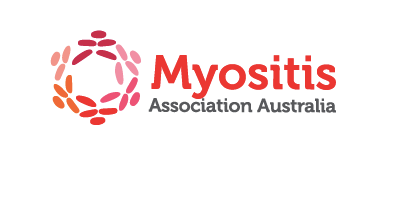Myositis Information for Health Professionals
Your role is critical
With the current average time to diagnosis of five years, GPs and other health professionals play a critical role in diagnosing this rare and progressive muscle disease.
The earlier a patient is diagnosed, the better their potential health outcomes will be.

May is Myositis Month
Understanding Myositis. Thank you to Civic Solutions Inc and students from Griffith Film School for helping to create this video.
About Myositis
Treating muscle weakness? Some things are not just part of getting older. It could be Myositis – a group of rare autoimmune conditions where healthy muscle tissue is destroyed instead of building new muscle tissue.
Myositis is sometimes misdiagnosed as motor neurone disease (MND). While it shares many of the severe impacts of MND, in terms of decreasing mobility, progressive leg and hand/ arm weaknesses and for some, the development of swallowing difficulty (Dysphagia), Myositis has a relatively low public profile. That’s why we are dedicated to raising awareness about Myositis to help people get diagnosed earlier, which could significantly improve their quality of life.
Physician’s Guide to Inflammatory Myopathies
Detailed information for diagnosing and treating Myositis is available in this Physician’s Guide to Inflammatory Myopathies. The Myositis Association (USA) has authorised the publication of the guide.
Myositis Specific Autoantibodies (MSAs)
Medical Practitioners are encouraged to order a MYOSITIS PANEL BLOOD TEST. Researchers continue to identify particular autoantibodies as biomarkers for Myositis diseases. These autoantibodies are rarely found in other diseases, so their presence in the patient’s blood can confirm the diagnosis of:
- Dermatomyositis
- Polymyositis
- Immune-Mediated Necrotizing Myopathies
- Inclusion Body Myositis.
MSAs and clinical features associated with them
taken from The Myositis Association (USA): https://www.myositis.org/about-myositis/diagnosis/blood-tests/myositis-autoantibodies/msas-clinical-features-associated/
| Autoantibodies | Clinical features |
|---|---|
| Anti-ARS (antisynthetase) | AS syndrome with moderate-to-serve muscle weakness with high muscle enzyme levels, RP, mechanic’s hands, fever, arthritis, and ILD |
| Anti-Jo-1 | Chronic continuous disease course, with clinical symptoms for >two years after diagnosis; mean five-year survival rate = 65%, usually due to ILD; AS syndrome features |
| Anti-PL-7 | AS syndrome with higher frequency of ILD |
| Anti-PL-12 | AS syndrome with higher frequency of ILD |
| Anti-EJ | Dermatomyositis and ILD |
| Anti-OJ | Myositis and ILD |
| Anti-KS | ILD with less myositis |
| Anti-Ha | NA |
| Anti-Zo | Myositis and ILD |
| Anti-SRP | Acute onset NM with severe weakness, high CK, cardiac involvement; refractory to treatment |
| Anti-Mi-2 | Adult DM and JDM with hallmark cutaneous disease, milder myositis with good response to treatment |
| Anti-TIF1-y (anti-p155/140) | CAM in adult DM; severe cutaneous disease in adult DM and JDM |
| Anti-SAE | Adult DM; may present with CADM first |
| Anti-MDA5 (anti-CADM140) | CADM; rapidly progressive ILD |
| Anti-NXP-2 | Predominantly JDM with subcutaneous edema, calcinosis, and servere muscle disease with contractures; increased risk of cancer in some adult DM studies |
| Anti-HMGCR | NM; associated with statin use in adults; severe proximal muscle weakness; partially responsive to immunosuppressive medications; better response to IVIg |
| Anti-cN-1A (Mup44, NT5c1A) | IBM; higher mortality risk |
ARS=aminoacyl-tRNA synthetase; AS syndrome=antisynthetase syndrome; RP=Raynaud’s phenomenon; ILD=interstital lung disease; SRP=signal recognition particle; T1F1-y=transcriptional intermediary factory 1-gamma; NXP-2=nuclear matrix protein-2; SAE=small-ubiquitin-like modifier activating enzyme; MDA5=melanoma-differentiation associated gene 5; CAM=cancer-associated myositis; CADM-clinically amyopathic DM; NA-not applicable/no data.
Diagnostic Criteria
The EULAR/ACR classification criteria for idiopathic inflammatory myopathies (IIM) were developed in 2017.
As part of this international collaboration, a web-based calculator was developed to estimate the probability of myositis diagnosis and subtype.
Patient Support
We are a registered charity who are here to support and advocate for your patients, whether they are living with Myositis or they are a carer, family member or friend.
Find out more about the support services we offer. This information is also available in a pdf flyer. Download here.
Please encourage your patients to visit www.myositis.org.au or more information about our work and support services or contact us on 0421 314 138 or mail@myositis.com.au.
vicdoc
MAGAZINE OF THE AUSTRALIAN MEDICAL ASSOCIATION VICTORIA LTD. AUGUST/SEPTEMBER 2017
Raising myositis awareness PDF
We have a panel of medical and allied health professionals who have experience in advising people living with Myositis. If you are interested in learning more, please contact us
